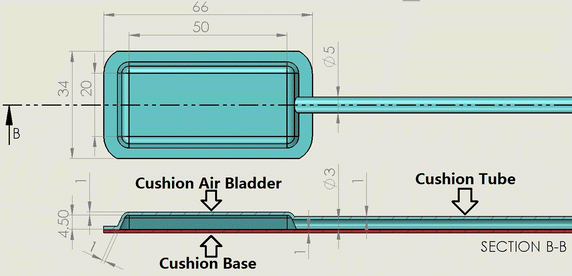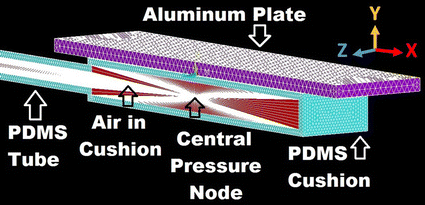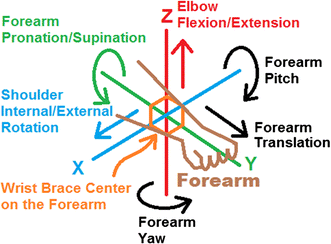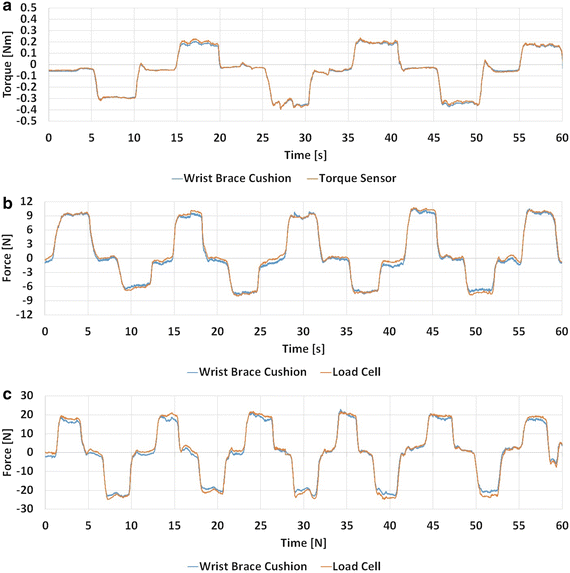A preliminary investigation into the design of pressure cushions and their potential applications for forearm robotic orthoses
- PMID: 28482892
- PMCID: PMC5422883
- DOI: 10.1186/s12938-017-0345-8
A preliminary investigation into the design of pressure cushions and their potential applications for forearm robotic orthoses
Abstract
Background: Load cells are often used in rehabilitation robotics to monitor human-robot interaction. While load cells are accurate and suitable for the stationary end-point robots used in rehabilitation hospitals, their cost and inability to conform to the shape of the body hinder their application in developing affordable and wearable robotic orthoses for assisting individuals in the activities of daily living. This exploratory work investigates the possibility of using an alternative technology, namely compliant polymeric air cushions, to measure interaction forces between the user and a wearable rigid structure.
Methods: A polymeric air cushion was designed, analyzed using a finite element model (FEM), and tested using a bench-top characterization system. The cushions underwent repeatability testing, and signal delay testing from a step response while increasing the length of the cushion's tubes. Subsequently, a 3D printed wrist brace prototype was integrated with six polymeric air cushions and tested in static conditions where a volunteer exerted isometric pronation/supination torque and forces in vertical and horizontal directions. The load measured by integrating data recorded by the six sensors was compared with force data measured by a high quality load cell and torque sensor.
Results: The FEM and experimental data comparison was within the error bounds of the external differential pressure sensor used to monitor the pressure inside the cushion. The ratio obtained experimentally between the pressure inside the pressure cushion and the 8 N applied load deviated by only 1.28% from the FEM. A drift smaller than 1% was observed over 10 cycles. The rise times of the cushion under an 8 N step response for a 0.46, 1.03, and 2.02 m length tube was 0.45, 0.39, and 0.37 s. Tests with the wrist brace showed a moderate root mean square error (RMSE) between the force estimated by the pressure cushions and the external load cells. Specifically, the RMSE was 13 mNm, 500 mN, and 1.24 N for forearm pronation/supination torque, vertical force, and horizontal force, respectively.
Conclusions: The use of compliant pressure cushions was shown to be promising for monitoring interaction forces between the forearm and a rigid brace. This work lays the foundation for the future design of an array of pressure cushions for robotic orthoses. Future research should also investigate the compatibility of these polymeric cushions for data acquisition during functional magnetic resonance imaging in shielded rooms.
Keywords: Air; Exoskeleton; Force; Polydimethylsiloxane (PDMS); Polymer; Rehabilitation; Sensors; Wearable.
Figures
















Similar articles
-
Movement Performance of Human-Robot Cooperation Control Based on EMG-Driven Hill-Type and Proportional Models for an Ankle Power-Assist Exoskeleton Robot.IEEE Trans Neural Syst Rehabil Eng. 2017 Aug;25(8):1125-1134. doi: 10.1109/TNSRE.2016.2583464. Epub 2016 Jun 22. IEEE Trans Neural Syst Rehabil Eng. 2017. PMID: 27337719
-
Supinator Extender (SUE): a pneumatically actuated robot for forearm/wrist rehabilitation after stroke.Annu Int Conf IEEE Eng Med Biol Soc. 2011;2011:1579-82. doi: 10.1109/IEMBS.2011.6090459. Annu Int Conf IEEE Eng Med Biol Soc. 2011. PMID: 22254624
-
Gravity compensation of an upper extremity exoskeleton.Annu Int Conf IEEE Eng Med Biol Soc. 2010;2010:4489-93. doi: 10.1109/IEMBS.2010.5626036. Annu Int Conf IEEE Eng Med Biol Soc. 2010. PMID: 21095778
-
Towards compliant and wearable robotic orthoses: A review of current and emerging actuator technologies.Med Eng Phys. 2016 Apr;38(4):317-25. doi: 10.1016/j.medengphy.2016.01.010. Epub 2016 Feb 26. Med Eng Phys. 2016. PMID: 26923385 Review.
-
Interface pressure reduction effects of wheelchair cushions in individuals with spinal cord injury: a rapid review.Disabil Rehabil. 2022 Mar;44(6):827-834. doi: 10.1080/09638288.2020.1782487. Epub 2020 Jun 23. Disabil Rehabil. 2022. PMID: 32573289 Review.
Cited by
-
Mobile Mechatronic/Robotic Orthotic Devices to Assist-Rehabilitate Neuromotor Impairments in the Upper Limb: A Systematic and Synthetic Review.Front Neurosci. 2018 Sep 5;12:577. doi: 10.3389/fnins.2018.00577. eCollection 2018. Front Neurosci. 2018. PMID: 30233289 Free PMC article.
-
3D Scanning of the Forearm for Orthosis and HMI Applications.Front Robot AI. 2021 Apr 14;8:576783. doi: 10.3389/frobt.2021.576783. eCollection 2021. Front Robot AI. 2021. PMID: 33937344 Free PMC article.
-
Integration of 3D Printed Flexible Pressure Sensors into Physical Interfaces for Wearable Robots.Sensors (Basel). 2021 Mar 19;21(6):2157. doi: 10.3390/s21062157. Sensors (Basel). 2021. PMID: 33808626 Free PMC article.
-
Occurrence and Type of Adverse Events During the Use of Stationary Gait Robots-A Systematic Literature Review.Front Robot AI. 2020 Nov 16;7:557606. doi: 10.3389/frobt.2020.557606. eCollection 2020. Front Robot AI. 2020. PMID: 33501319 Free PMC article.
References
-
- Ang KK, Guan C, Phua KS, Wang C, Zhou L, Tang KY, et al. Brain-computer interface-based robotic end effector system for wrist and hand rehabilitation: results of a three-armed randomized controlled trial for chronic stroke. Front Neuroeng. 2014;7:30. doi: 10.3389/fneng.2014.00030. - DOI - PMC - PubMed
-
- Gupta A, O’Malley MK, Patoglu V, Burgar C. Design, control and performance of ricewrist: a force feedback wrist exoskeleton for rehabilitation and training. Int J Robot Res. 2008;27:233–251. doi: 10.1177/0278364907084261. - DOI
Publication types
MeSH terms
LinkOut - more resources
Full Text Sources
Other Literature Sources

